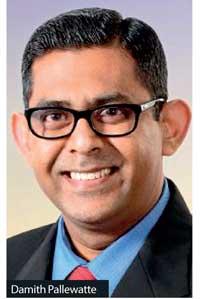27 Dec 2021 - {{hitsCtrl.values.hits}}
Questions are being raised abundantly whether the rock bottom interest rates which came about since the onset of the pandemic to both blunt its economic fallout and also to support the subsequent recovery have delivered intended results as a senior banker last week said the easy money regime in hindsight had in fact resulted in some pervasive outcomes, which now have come to haunt the entire economy.
 According to Damith Pallewatte, Deputy General Manager, Wholesale Banking Group at Hatton National Bank PLC, the ultra-low interest rates have erased the real incomes of a majority who depend on interest incomes, while the continuous liquidity injections made, intended for channelling into productive sectors of the economy, hasn’t produced the expected results.
According to Damith Pallewatte, Deputy General Manager, Wholesale Banking Group at Hatton National Bank PLC, the ultra-low interest rates have erased the real incomes of a majority who depend on interest incomes, while the continuous liquidity injections made, intended for channelling into productive sectors of the economy, hasn’t produced the expected results.
He pointed out that such massive amounts of money, which sloshed the market, went into consumption, which in turn pushed national inflation to double-digit levels in November, along with the supply chain bottlenecks caused by the pandemic-induced restrictions.
“Whilst on one side, the borrowers save money on their finance cost, there is a huge component of low and middle income earners who depend on savings. Their real returns have gone down significantly,” Pallewatte told an online forum conducted by Advocata Institute, as part of its AdvoChats series of weekly discussions.
“Ordinary saver’s spending pattern is not reflected in the Colombo Consumer Price Index. As a result they are not getting a real return on their savings. Their living standards are going down,” he added taking part in the discussion titled, ‘Is Sri Lanka’s financial sector in peril?’
Sri Lanka’s consumer prices measured by the CCPI, the preferred inflation matrix, rose by 9.9 percent in November while prices measured by the National Consumer Price Index climbed 11.1 percent from a year ago with food prices surging by a massive 17.5 percent.
In spite of the August policy rate hike, the market rates haven’t budged much although they remain skewed to the upside, but the still very low deposit rates aren’t beating the inflation nearly.
Soaring prices coupled with the loss of incomes as a result of the pandemic have caused massive economic hardships for people, significantly impacting their living standards.
Pallewatte also said the current policies in place could be the recipe for creating a large wealth gap in the society which could give rise to an extremely limited number of ultra-rich people and a massive number of low and middle income class people, who will have to be sustained by the governments.
“Probably we are moving towards very limited number of extremely rich people and a massive population of low income, subsidy-dependent people,” he opined.
Hence, one must take extreme caution when injecting massive amounts of liquidity via printed money thinking that the economy can be supported, he advised.
He expressed his doubts about whether printed money had in fact reached the intended productive sectors of the economy as a large amount of money had found its way into consumption.
“Printed money has gone to unproductive sectors of economy. It has mainly gone for consumption whereas it has not supported any productive sectors in the economy,” Pallewatte said.
“So, what happens is that from one side when your interest rates are low, you make some savings because your (interest) costs have come down. On the other side, you have been given a debt moratorium where you don’t have to payback at all during a particular period. So, there is an amount of money left which can go into savings which doesn’t generate a return,” said the banking veteran with nearly three-decade of experience in the sector.
He also said he sees these moneys being channeled into real estate which has gone up in demand and in prices substantially as of late.
16 Nov 2024 21 minute ago
16 Nov 2024 45 minute ago
16 Nov 2024 58 minute ago
16 Nov 2024 3 hours ago
16 Nov 2024 5 hours ago